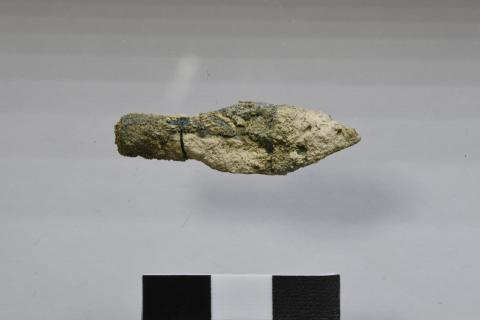The discovery is of a deposit including layers of ash, arrowheads dating from the period, as well as Iron Age potsherds, lamps and a significant piece of period jewelry - a gold and silver tassel or earring. There are also signs of a significant Iron Age structure in the associated area, but the building, beneath layers from later periods, has yet to be excavated.
The team believes that the newly-found deposit can be dated to the specific event of the conquest because of the unique mix of artifacts and materials found -- pottery and lamps, side-by-side with evidence of the Babylonian siege represented by burnt wood and ashes, and a number of Scythian-type bronze and iron arrowheads which are typical of that period.

One of the Scythian type arrowheads found in the destruction layer from 587/586 B.C.
Image: Mt Zion Archaeological Expedition/Virginia Withers
Because of the site's location, various alternative explanations for the artifacts can be eliminated, the researchers argue. "We know where the ancient fortification line ran," notes UNC Charlotte professor of history Shimon Gibson, "so we know we are within the city. We know that this is not some dumping area, but the south-western neighborhood of the Iron Age city - during the 8th century BCE the urban area extended from the "City of David" area to the south-east and as far as the Western Hill where we are digging."
The ash deposits alone are not conclusive evidence of the Babylonian attack but in the context of other materials it can be inferred. An ashy layer full of artifacts, mixed with arrowheads, and a very special ornament indicates some kind of devastation and destruction. Nobody abandons golden jewelry and nobody has arrowheads in their domestic refuse.
The arrowheads are known as 'Scythian arrowheads' and have been found at other archaeological conflict sites from the 7th and 6th centuries B.C. They were fairly commonplace in this period and are known to be used by the Babylonian warriors. Together, this evidence points to the historical conquest of the city by Babylon because the only major destruction in Jerusalem for this period is the conquest of 587/586 B.C.
The clay artifacts also help date the discovery. The lamps are the typical high-based pinched lamps of the period.
"It's the kind of jumble that you would expect to find in a ruined household following a raid or battle," Gibson said. "Household objects, lamps, broken bits from pottery which had been overturned and shattered... and arrowheads and a piece of jewelry which might have been lost and buried in the destruction. "Frankly, jewelry is a rare find at conflict sites, because this is exactly the sort of thing that attackers will loot and later melt down."
"I like to think that we are excavating inside one of the 'Great Man's houses' mentioned in the second book of Kings 25:9," Gibson speculated. "This spot would have been at an ideal location, situated as it is close to the western summit of the city with a good view overlooking Solomon's Temple and Mount Moriah to the north-east. We have high expectations of finding much more of the Iron Age city in future seasons of work. "






Comments